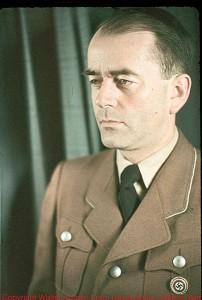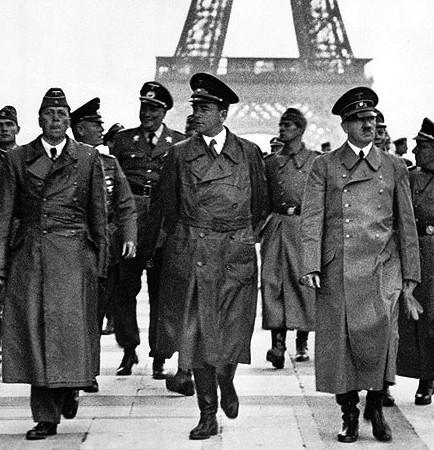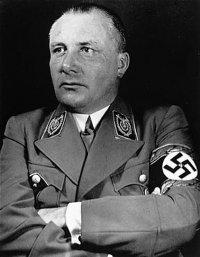Battle of the Architects, Part 5


Hermann Giesler on left; Albert Speer on right,
THE DISCORD
Translated and condensed from Hermann Giesler's Ein Anderer Hitler by Wilhelm Kriessmann and Carolyn Yeager
This is a condensation of the 15-page section Der Zwist on pages 340-355
copyright 2014 Carolyn Yeager
“ Powerful and at the same time not interested in power” … so judges the American historian, Professor Eugene Davidson, about the author Adalbert Speer, when reviewing his book Erinnerungen.

The following footnote (Chapt. 4, #32) from Joachim Fest’s Speer: The Final Verdict reveals the disdain Albert Speer felt toward Hermann Giesler that was probably the root of the problems between the two men.
“… in the caption to the picture showing Hitler in front of the Eiffel Tower, (Speer) mentions Breker but not Giesler on his right. […] In conversation Speer remarked that Giesler had been distinguished “beyond merit” by Hitler's invitation. Asked if he had been jealous of his rival, he replied, ‘How should I have been jealous of him? Giesler was a frightful petit-bourgeois! How could he supplant me in Hitler's favor?’ […] How unremitting Speer’s feelings were for Giesler emerges also from the fact that he consistently misspells his name with what seems like pointed indifference.”
Giesler chronicles his major dispute with Albert Speer as beginning in late autumn 1940 when he received from Hitler the task of designing the renewal of Linz, in addition to Munich. After that, Speer had asked Giesler if he would agree to his (Speer) taking “over-all control” of all city building work in Germany and with it over-all responsibility. “In the future I would like to be involved more than I am now with the Gaustaedte (cities in the party districts/provinces) where questions about city renewal might arise which are also connected with party buildings. I believe this is necessary in order to avoid wrong planning.”

Another reason he put forth was that it would make it easier for the Führer to make decisions. Giesler, who saw himself and Speer as a team functioning cooperatively for the good of Germany, and being already overloaded with responsibility for the planning of Weimar and Augsburg, replied, “Naturally, I would agree.” (image: left to right, Giesler, Speer, Hitler, Roderich Fick in Linz on the Danube)
A few months later, Giesler received a letter from Speer in which the latter referred to the former's “joyous” agreement, and concluded, “Your approval was one of the most important requirements to take further steps.” Steps where, Giesler wondered?
Soon, it was obvious. Their casual agreement resulted in allocations for the Munich renewal (G's assignment)—primarily steel and iron—to be taken care of by Speer's Reich office of Generalbauinspektor (General building inspector) in Berlin. After work had begun on the federal railway system in Munich, all allocations stopped and every effort brought no results. “The reputation of the office under my leadership was at risk,” writes Giesler. He requested a meeting with Dr. Fritz Todt, at which it was made clear that all G's requests for allocations were entirely dependent on Speer and his allocations administration.
“But not only that, all deadlines for construction, dispositions and new planning projects were not able to be met by me. The complaints of the railway management for new projects and their construction piled up at the ministry and at my office work was partly stopped.”
Giesler again went to Dr. Fritz Todt and spoke frankly, but with no success. Speer was favoring his own projects.
It was the same with the supply of stone material—they were in the hands of Speer and were not sent to Giesler. On his own, he could get hold of only concrete and a limited supply of Tuscan travertine. At this point, Giesler recalled Adolf Hitler telling both him and Speer that if they had any problems with these important building assignments to go to Bormann and he would help them. This Giesler did, and Martin Bormann (below right) met with Dr. Todt and Speer and asked for a letter from Giesler explaining the situation at his building sites caused by poor allocations. In his letter, Giesler asked that Dr. Todt take over the administration and distribution of allocations.

Once Bormann saw the scope of the problem, he sought to avoid a serious discord by asking Giesler to hold back. Toward the end of 1941, Speer drafted a Führer-Directive to forward to Hitler which gave him (Speer) absolute power of decision for all building projects in the Reich. Giesler says he knew such a directive would never be approved and thought that Speer also must have known that Adolf Hitler would not have considered a “central responsibility” and “central direction” proper for all these artistic creations, in a federally structured Reich with it's traditionally grown and regionally cultured Gaue. And, indeed, Speer withdrew it before it reached Hitler.
Now Speer went in the opposite direction. Bruised by his failed attempt at a total takeover, he decided he didn’t want any responsibility except for his own projects of Berlin and Nuremberg. On Jan. 20, 1942 [just so happens to be the day of the alleged Wannsee Conference -cy], Speer informed Reichsleiter Bormann that he was relinquishing all responsibility for [NSDAP] Party buildings which he had formerly held. That decision, Speer said, was caused by the negative opinion of his Fuehrer-Directive expressed by Professor Giesler. He further stated that he would now have free time at his disposal and asked the Führer to entrust him with the building of the new city of Drontheim [southwest of Trondheim in Norway].
Speer's unusual birthday present to the Führer
Amongst other shenanigans and intrigues, Speer also sought to undercut Giesler’s authority for the Linz city building project by bringing a birthday greeting to Hitler at midnight on April 20, 1941 in the form of an offering which read:
My Führer—On your 52nd birthday the undersigned artists of Berlin’s renewal beg you that they may participate at the noble competition for the new layout of the city Linz at the Danube.
It was signed by Speer and 15 of his Berlin team of architects, sculptors and painters. Giesler had already been designing, at Hitler’s request, the Linz plans and models for 6 months! Writes Giesler:
When I read this [in the Party Chronicle] after so many years I was perplexed. Was that really the reason Adolf Hitler made the remark at our meeting at the headquarter Winniza, 1942 , when he said : “in the future you select the architects you want to work with at Linz.” His entourage, who knew about that strange birthday, did they not wonder? I can understand that Bormann did not want to stir up the matter; he rather wanted to defuse the quarrel between Speer and me.
That's how it was at that time—Speer did not miss a minute to make the Führer happy. Or was it a limitless and offended ambition which encouraged him as manager, coach and player of his national team of architects, sculptors and painters, all bound to duty at Berlin, now to enter the field of the Linz renewal? Why really—to drive away the lonely one, entrusted by Adolf Hitler to plan his retirement seat at his hometown, by a “noble competition”? […] Anyway, to present that proposition as a birthday present—I consider this even today as tasteless.
Fritz Todt dies; Speer advances to Minister level
When on Feb. 8, 1942 Dr. Todt died in an airplane crash and Speer became the successor to his office, the two architects had a meeting and made a peace, as had been Todt’s wish, and also Bormann's directive. But it was a practical one, writes Giesler, and adds that it ended for him “with Speer’s statement at the IMT [International Military Tribunal] and again when he spoke Sept. 30, 1966, the day of his freedom.” The ‘friendship’ was finally buried amid “the pile of Speer’s silly distortions and proofs of his successful "re-education" by his statements, interviews and books.”
There are in front me notes about Speer's letter to Bormann Jan. 2, 1942, ending : “Therefore, my only New Years wish for you: to give the Führer by your responsible work in the year 1942 much joy and few disappointments. In friendship and dearest greetings, Heil Hitler! Your Albert Speer
And here is the Playboy interview with the question :
What kind of a man was Bormann?
Speer: “He was the roughest, most brutal and merciless member of the Nazi hierarchy—and believe me that means something. Personally, he was violent and primitive, without any culture or sensitivity. By nature he was a servile person but also a brute, treating his staff like animals with a sadistic contempt for their feelings. Either he crawled at their feet or went after their throat, a most evil type of a farmer with the most evil kind of a farmer’s slyness. He knew how to mislead people so that they believe him to be an unimportant, trustworthy helper of the Fuehrer, while all the time cunningly building his own empire.”
Quite different from this hateful image Speer was drawing of Bormann were his hackneyed phrases with which he finished his letters to Bormann: “And I beg you most sincerely to give me your friendly support” and “in friendship and with dearest greetings.”
Giesler ends with words he received a few years ago from a former colleague on the Weimar and Munich projects: “Mr. Giesler, you have to admit that Speer was far superior to you.” Giesler agrees:
Well, naturally he was, I said, and how!
and thinks about why that was so. Speer was both a mathematician and an architect—with a mathematician's controlled thinking. For the sake of control, he wanted supervision. He had everything at his disposal--a large office with excellent architects, city builders, engineers, landscape architects, sculptors and painters--and could delegate to others, giving him time and working strength to do that which he wanted to do himself.
I was only an architect. Speer was mighty … yet, at the same time, with no interest in power.
~END
Tags
architectsCategory
Adolf Hitler, Art & Culture- Printer-friendly version
- 3824 reads









